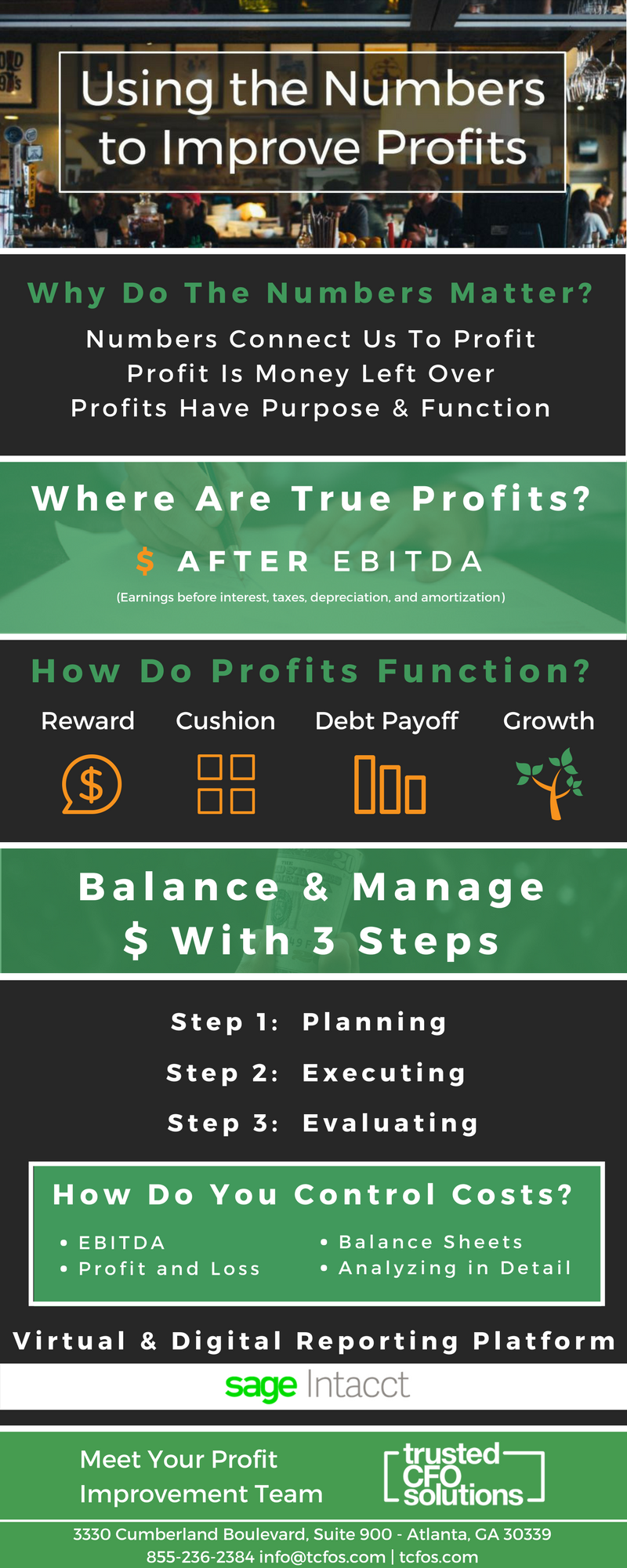
Webinar: Involve Your Restaurant Managers In The Numbers
What Is The GRA?
The mission of the Georgia Restaurant Association is to serve as the voice of Georgia’s restaurants in Advocacy, Education and Awareness.
The Georgia Restaurant Association (GRA) has operated as the voice for Georgia restaurants since 1906. They have very limited knowledge of the association’s activities until 1972 when under the leadership of Marge McDonald the GRA joined with the Georgia Travel, and Georgia Hotel and Lodging Association, which then fell under the umbrella of the Georgia Hospitality & Travel Association (GHTA) as its foodservice division (GRA) to merge the three organizations into one at that time.
What Is This GRA Webinar About?
Join Steve Gross, Co-Founder, and CEO of Trusted CFO Solutions, to discuss Involving your restaurant manager in the Numbers. He’ll explore the following topics.
- How to measure and monitor floor and kitchen activity
- Basic profitability, costs, and performance
- Manage costs in every area
- Match staff costs to revenue by shift and day
- Target costs vs Actual
- Industry norms & standards
Watch This On-Demand Webinar
Listen To The Webinar
About Steve Gross
 Steve is a big picture thinker and connector, with 40 years of rich and diverse experience in the C.P.A., business consulting, and venture capital worlds. Learn More…
Steve is a big picture thinker and connector, with 40 years of rich and diverse experience in the C.P.A., business consulting, and venture capital worlds. Learn More…
Webinar Transcription
This webcast transcription has been edited for better readability.
Our webinar today is presented by Steve Gross, Co-Founder and CEO of Trusted CFO Solutions.
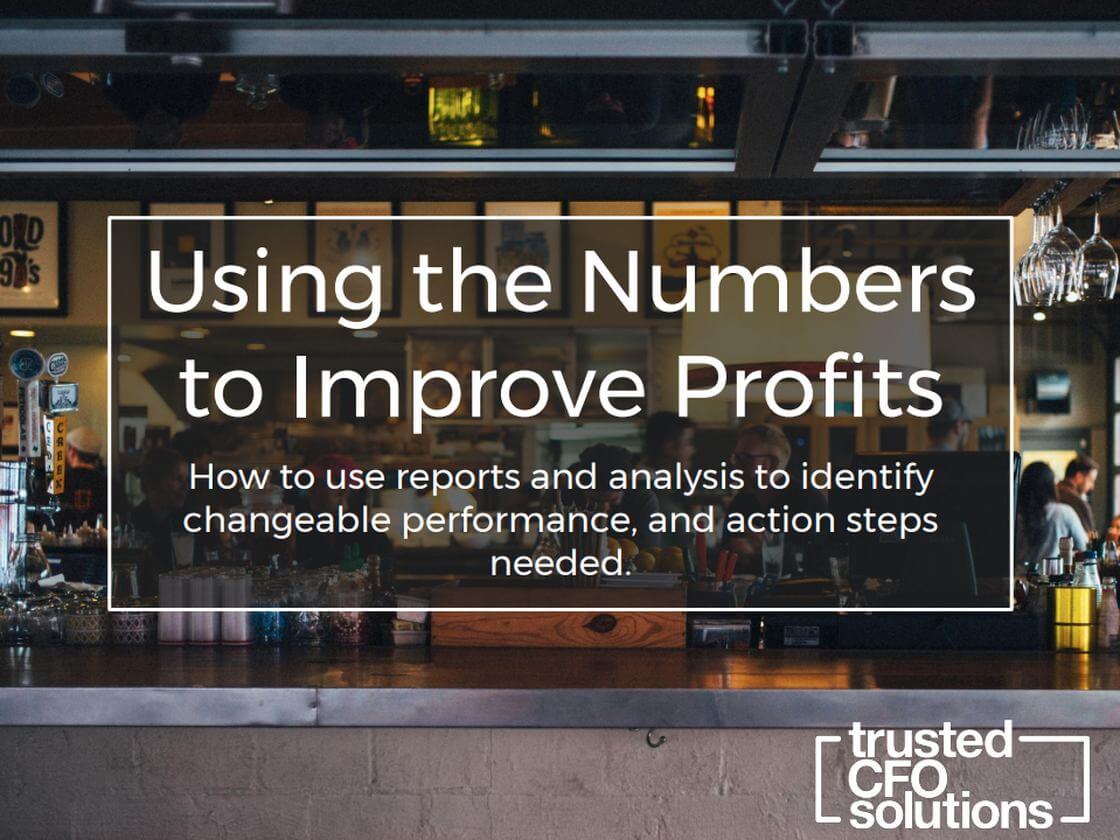
This presentation will focus on understanding how to measure and monitor activity on the floor and in the kitchen. It will give a basic understanding of profitability including; cost and performance, how to manage cost in every area of the facility, how to match staff cost to revenue by the shift and by the day and target cost versus actual cost. At this time I would like to go ahead and turn it over to Steve for our presentation.
Our Presenter
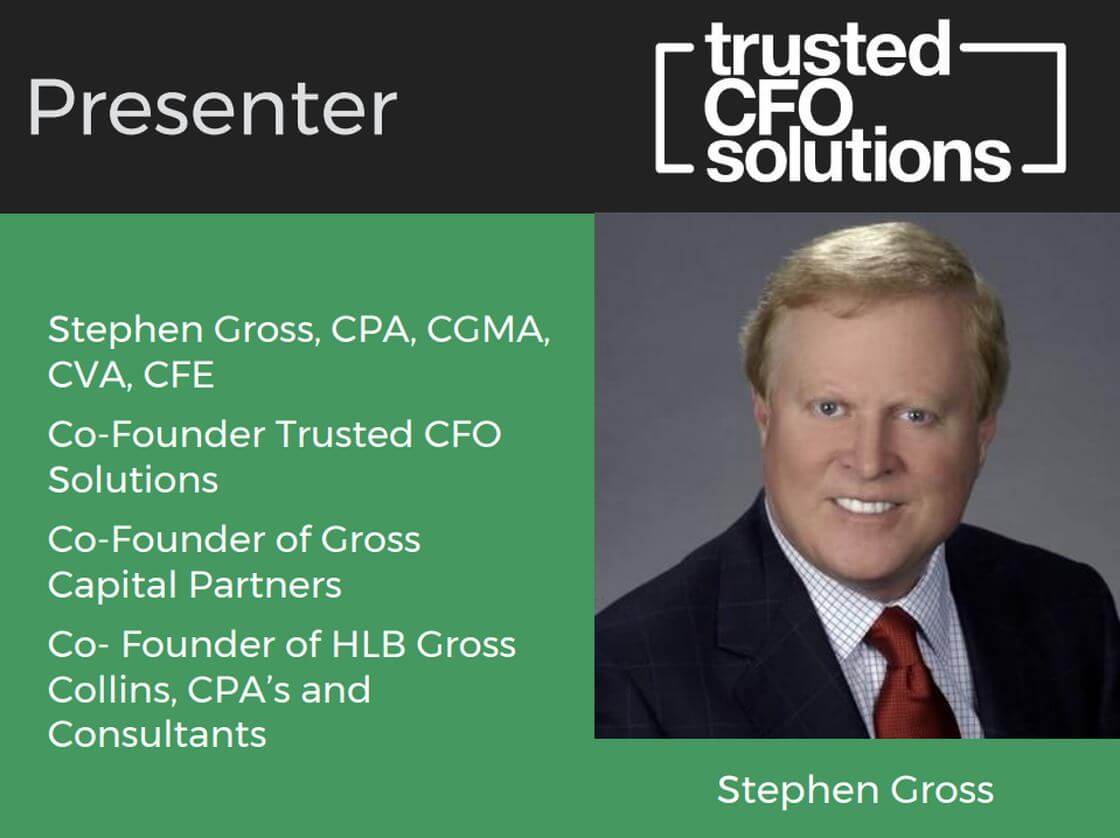
Thank you so much for the opportunity to talk and share thoughts and ideas with you today. My background is a restauranteur. I was an Arby’s franchisee for 15 years. During that time I had the privilege of a partnership with Hank Aaron at the 755 Management Group. After they sold their Arby’s units in Milwaukee, the 755 Management Group moved on to America’s favorite chicken. It was building a Popeyes and a Churches store in the early days of the takeover from Al Copeland that led them into a long and prosperous career.
In my career as a Franchisee, I experienced many issues when first opening stores. A significant challenge was watching and monitoring the performance of stores, going through decisions on what kind of marketing to implement by location, and dealing with multiple unit management while needing to watch over many people doing various things. Add to that the difficulty of trying to make sense of it all. We did this as we rolled out the 2nd, the 5th, the 10th, and the 15th unit.
Later on, I was fortunate or unfortunate as the case may be, to be the operating partner of a high-end dining restaurant in Sandy Springs, Georgia. For five years we had quite a good time serving delicious food and wine to the community in and around Sandy Springs. I will say that I learned a lot from that experience. I suffered many scars and bruises along the way. By going through those hardships, I can sympathize with the challenges of what to do to make things better from the perspective on one in the restaurant, to own the restaurant, and to work at the restaurant. So, from the standpoint of an Operator, of a Manager of multiple units, and of being a CPA, I’ve lived the life that you’re living, and I have a sincere appreciation for what happens every day.
Our session today is going to be talking about using numbers to improve profits. Subtitled, how to use reports and analysis to identify changeable performance and action steps needed. What I mean by that is, many things are going on in any restaurant. It is primarily a people, inventory, and manufacturing business. You’ve got numerous things happening in the front and back of the house, in the bar and the kitchen, with the ordering and replenishing, and keeping menus updated while trying to understand what’s making you money and what’s not.
There is much activity from early morning until late at night; there is always something to do, someone to deal with, and a problem to solve. In my experience, the least favorite thing to do in owning and operating a restaurant is dealing with numbers, accountants, bookkeepers and the reports. Very few people who go into the restaurant business have a management reporting background. So number one, I’m familiar, number two, it’s uncomfortable, and number three, there is a pervading sense of, “I’m not entirely sure of what I’m looking at, so I’m not entirely sure how to use it.“
What we are going to try and do today is make it a little more comfortable and a little simpler to understand where the numbers fit, how to use them for positive change, and what to measure to figure out what’s happening well and what’s not. I submit my bio here just for information purposes. My personal and professional training is in analyzing, accounting, financial review and building businesses as an advisor. I’ve been on the same side of the table, with many of you owners and operators strategizing to figure out how to improve where we are and how to manage what we have. Part of today is sharing some of those insights with you.
Purpose of This Session
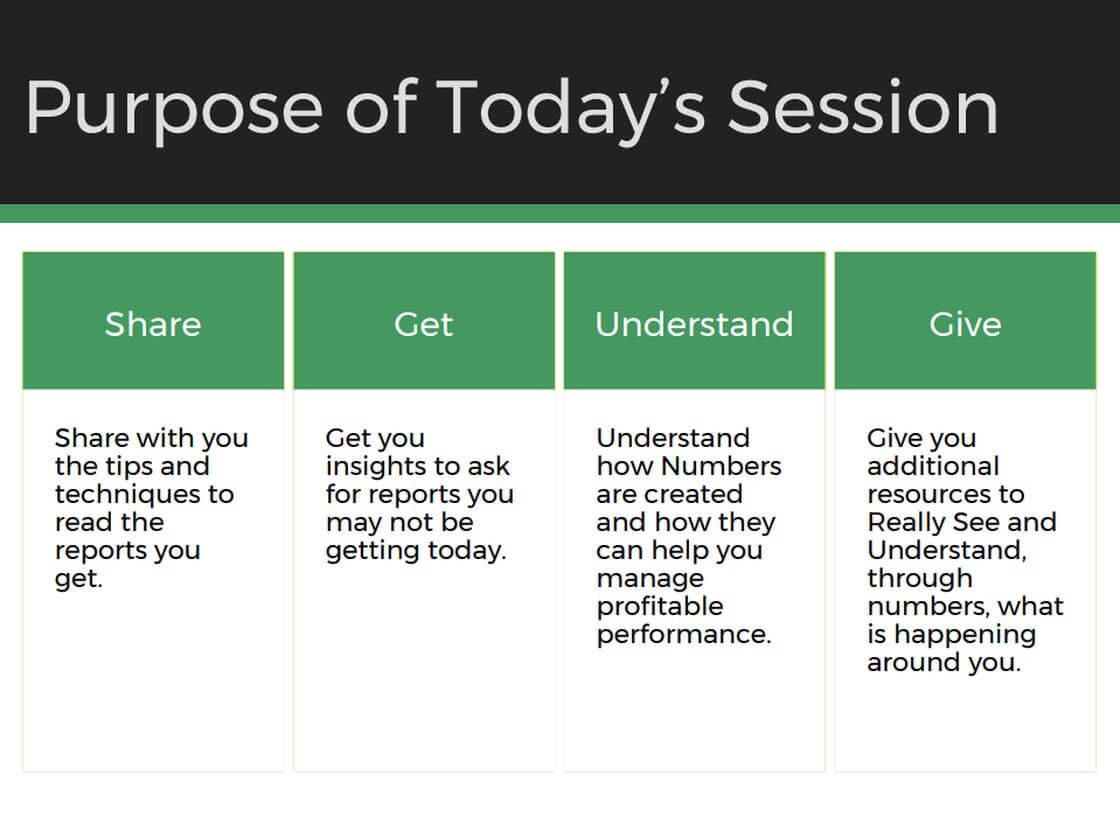 So, what we’re going to try to do is share with you some tips and techniques, how to read reports you get. We’ll take a look at what you’re getting routinely today and then help you with the thought that there are additional insights you can ask for in report you may not be getting. We’ll help you know where to go, what to ask for, and what to view. Third, we will understand how the numbers are created, where they come from, and their make-up. I have experienced all kinds of misunderstandings in operating restaurants. Even experienced general managers and owners misunderstand where the numbers come from and what they mean. So we will go over some basics to keep your attention while we go back to some elementary, but fundamental principles to help you understand.
So, what we’re going to try to do is share with you some tips and techniques, how to read reports you get. We’ll take a look at what you’re getting routinely today and then help you with the thought that there are additional insights you can ask for in report you may not be getting. We’ll help you know where to go, what to ask for, and what to view. Third, we will understand how the numbers are created, where they come from, and their make-up. I have experienced all kinds of misunderstandings in operating restaurants. Even experienced general managers and owners misunderstand where the numbers come from and what they mean. So we will go over some basics to keep your attention while we go back to some elementary, but fundamental principles to help you understand.
Then, we’ll talk about giving you some additional resources to see and understand what’s happening around you analytically. Now, my experience is that different people learn and interpret information from various types of presentations. Some are very aligned to watching a visual presentation, like listening to a TV report or webcast, others attune to reading about things; they love books, common narratives, and they understand and resonate with narrative descriptions of what’s going on. The third way and the way that is the most uncomfortable for many, is analytical, to look at numbers. To understand that numbers are only measurables is like asking someone if they are 5-foot 11-inch or 6-foot 1-inch. Another example is asking someone if they weigh 170 lbs or 190 lbs. All it is is a measurement. It describes something. What we are going to talk about today is what those numbers represent and how you can watch activities by understanding numbers. I want you to know how those numbers mean something to you and what you can do once you know what they say to make them different.
Why Do Profits Matter
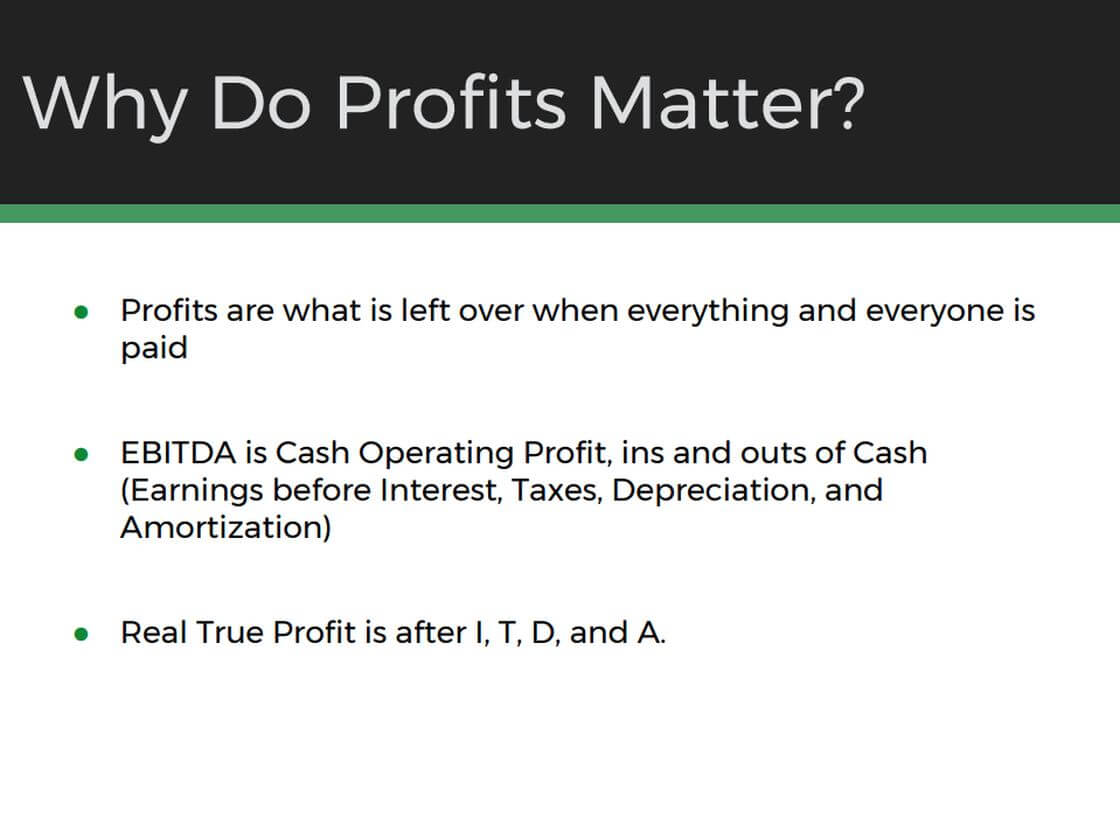
I’m going to talk about profits for a moment because this is an area that I find our new generations of employees vastly misunderstand. Profits have almost become a negative connotation. Profits mean someone’s getting ripped off, someone is taking advantage of someone else, someone is unfairly and title to something in the modern culture. None of that is correct by definition, or by reality, and I want to reinforce what profits are and why they matter to your business. First, profit is what’s left over after everything, and everyone gets paid. When the cost of running the business is taken care of, everything is covered; taxes, people, vendors, and the profit is what is left. Many people manage to a term called EBITDA. EBITDA is a term for profit, but it means cash operating profit. It’s basically what the business is doing and ignores interest, taxes, depreciation, and amortization. So, it’s an accurate measurement of how the business is operating. It doesn’t mean profit. So that our definitions are clear, true profit is after interest, taxes, depreciation, and amortization.
The point I want to make is what profits do to business. They have a purpose and a function.
Profits Have A Purpose And A Function
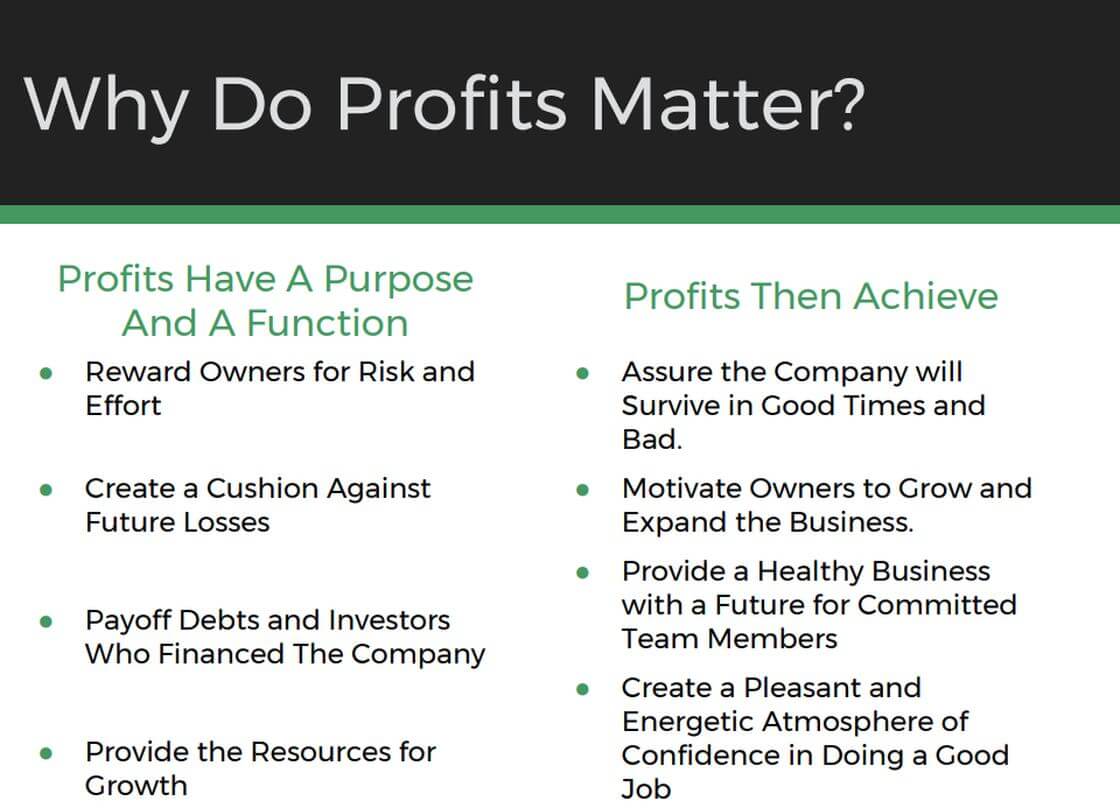
First, it rewards owners for the risk and the efforts of doing it in the first place. If they didn’t expect a profit, they wouldn’t have gotten in the business at all. No one would have a job; there would be no storefront, there would be no operations. So, profit is the magnet that draws an owner to come in and take a risk.
When a business is profitable, it creates a cushion against future losses. Just because you come out of the gate with the hot new thing and you start generating profit, it doesn’t mean it’s going to stay that way forever. So the profits you might make early will be there as a buffer for the business to take root and prosper over the long term. Without that kind of profitable cushion, the company can go out of business in a hurry.
Also, profit is used to pay off the debt you incur when you go to the bank and borrow money. When investors are putting up money to help you open the restaurant, they ultimately have to be repaid. The repayment of that money comes out of profits. It doesn’t just show up out of thin air. So the company has to be profitable and create extra cash to pay those debts down and to pay investors what they hope to get in return when they took a chance to back the owner.
Moreover, profits are the only resource you have to grow. So, if you’re not making money, you’re not going to rise to the 2nd, the 10th, and to the 15th unit. It won’t happen because you can’t grow with a break-even business or a business that’s losing money. What having profits creates, is first ensuring the company will survive in good times and in bad times and second excites the owners motivating them to expand the business. Having seen that you as an operator can make money, it’s a good concept, your customers like it, and it’s profitable. That provides a springboard to open the 2nd, the 3rd, and so on unit following that path.
The next thing I think you ought to take advantage of and ought to resonate is, it provides a culture so that committed team members, people who like the industry, like the business, it gives them a platform for growth. If you’re in one unit, and that unit’s been there for 25 to 30 years, everyone will settle into a position that there’s no real upward growth. Growth comes from opening new units and having the people excel in that first unit, in that second unit, and that fifth unit to take on management roles and responsibilities in the newer units. So, a profitable company creates a platform for growth.
Also, I think the final thing to say is that whenever you walk into a restaurant, and you see motivated servers and the floor staff having a good time with their customers, you have a sense that it is a profitable operation. Everyone is pleasant; everyone is energetic, everyone seems self-confident. That’s the sign of a restaurant doing well.
A Look At How Profits Are Configured and The Mechanics of A Profit & Loss
So, let’s look at how profits are computed and what you do to figure out whether you’re making money. A financial statement is broken down into two pieces.
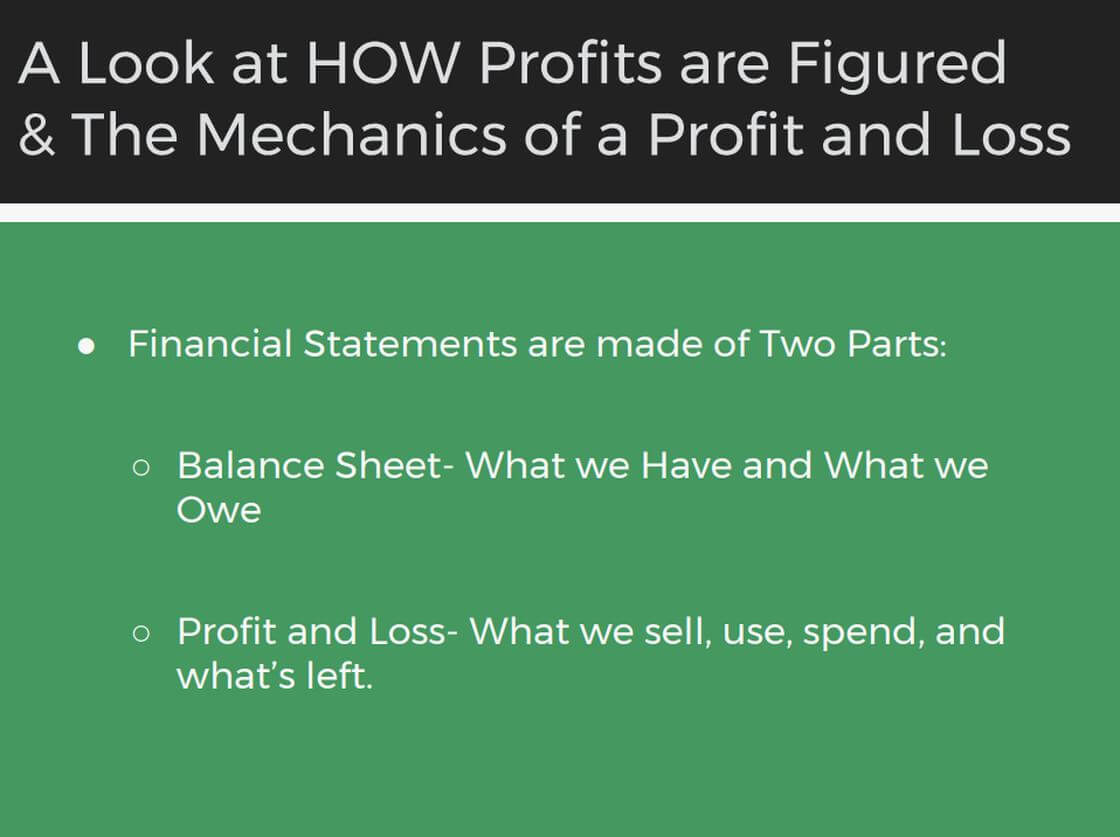
Balance Sheet: What We Have And What We Owe
A balance sheet is what we have and what we owe, our profit and loss. What we sold, used, spent, and how much is left. So we have assets and liabilities which is the balance sheet. Also, we have profits and losses which is the revenue minus expenses. They are two separate statements. When you hear double-entry accounting, it’s because these two balance each other. The balance sheet is one side, profit-loss is the other. What impacts the balance sheet may impact profit loss, but everything balances and nothing is left out by doing the financial statement that way.
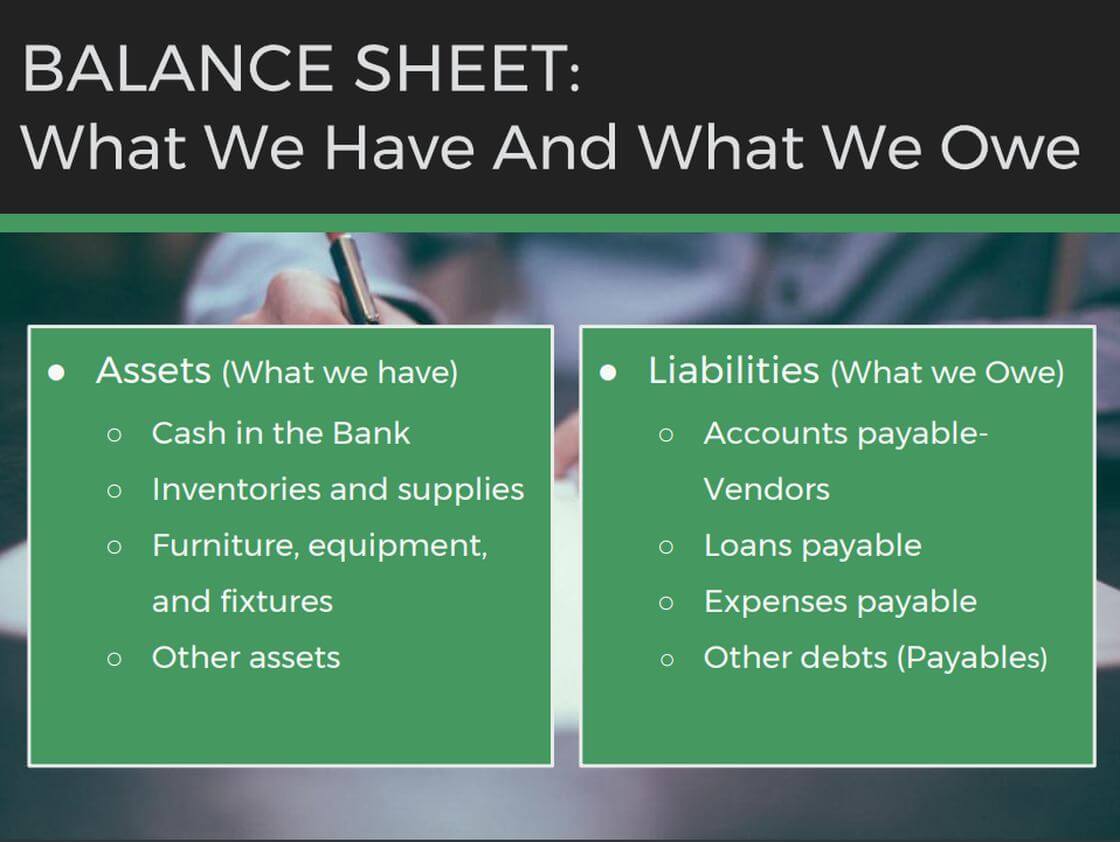
So, the balance sheet very is merely what we have and what we owe. It includes the cash in the bank, the inventory, and supplies we have, what we have spent on furniture, equipment, fixtures, linens, supplies, everything that’s out there on the floor, then other assets. There may be prepaid insurance, different types of things that have been deposits on leases; all of those are what we have in the assets. The liabilities, on the other hand, is what we owe. As we are buying things and we are receiving them on credit, we create accounts payable. And this is what we owe our vendors, from what’s coming in and used in operations. We may have borrowed money from the SBA, from friends and family, or from the bank to open the restaurant. It’s the actual liability, that’s part of what we owe. Expenses payable usually refers to items that have been spent but have not been written off in expenditures yet. So, it’s money that we owe; it would be cut-offs for payables, accrued, payroll, sales tax, liabilities, things that are typically expenses in the business, but we have not paid them, then other debts. There could be a variety of those types of things. In each business it’s different, but you can open other money to other people. This is where you show it off if you have those kinds of things. So again, the balance sheet is what we have and what we owe.
Balance Sheet: How It Works
How it works is very important, and I find that managers and owners often misunderstand. When you buy food, liquor, wine, beer, and supplies it doesn’t go to the P & L; it doesn’t go to the expenses, it goes to the balance sheet. It’s an asset you just acquired. So it will go on the balance sheet as an asset. It will go to inventory; it will go to payables if you haven’t paid for it it will go to cash. However, it goes to the balance sheet as an asset at the moment.
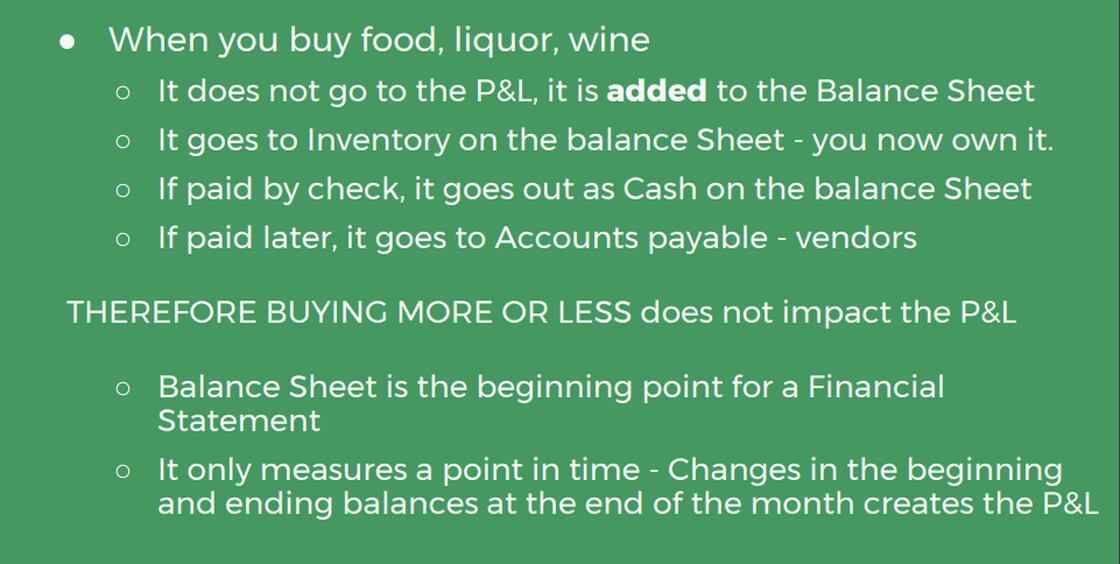
So the point here that I have heard many many times is when the back or front of the house wants to cut food costs, “we’ll just buy less.” That has specific logic to it, but the cost of goods sold and the cost of what you’re using in your restaurant has nothing to do with what you buy. What you buy is only the beginning point for this. It measures changes in the beginning and the ending balances. In theory, you buy inventory, and it’s put into the refrigerator, and stored on the shelves. Then, during the month you use what you have and purchase additional inventory. Then, at the end of the month, you count what you have less inventory at the end of the month. The difference is your expense. So it’s coming in as an asset, it’s getting used as an asset, it’s getting replenished, and then it’s getting counted at the end of the month. So the only thing that matters is what you use, not what you bought. So, when someone says control cost by buying less, they don’t understand this principle. I can’t tell you how many times I’ve heard that from operators who haven’t had the financial training or this has not been explained to them. So, I want to double underline that. You don’t control costs that are sold, by buying less.
Profit and Loss: What We Sell, Use & Spend = What’s Left
What we sell, use, and spend equals what’s left. The basic formula is revenue less controllable expenses less non-controllable expenses equals profit. So when you’re looking at a profit and loss, this is the machinery that will tell you whether or not you’ve made a profit.
Revenue is the total amount of sales that are happening. In restaurants, it’s usually the amount that goes through the cash register. However, it can also be events, catering, Uber Eats, or a variety of others. It can be take-out, there are some different elements to it. Still, what you sell is the easiest thing to measure.
Cost Of Goods Sold – Controllable Costs
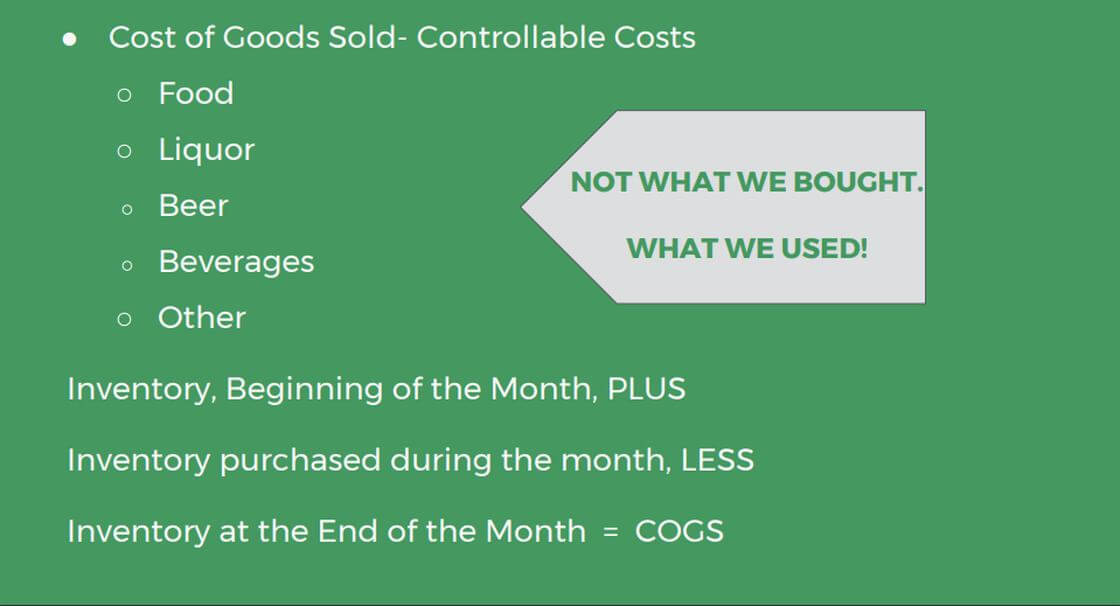
Cost of goods sold as controllable costs includes food, liquor and beer, beverages and other items going in that. Inventory computes it at the beginning of the month plus inventory purchased during the month less inventory at the end of the month. That’s what we talked about a minute ago. That’s your cost of goods sold. So, if you hear food costs are too high, something is happening in the movement of inventory, and the use of the inventory is causing that percentage to be too high.
When managing your costs of goods sold the following are the items you need to review. First, the ingredients you need are products sold. That’s the flow of your menu. It’s the flow of the goods that are going into revenue, into the customer’s hands, and it’s the cost of what they are receiving. However, there are other items you have to watch out for too.
Inventory Used = COGS
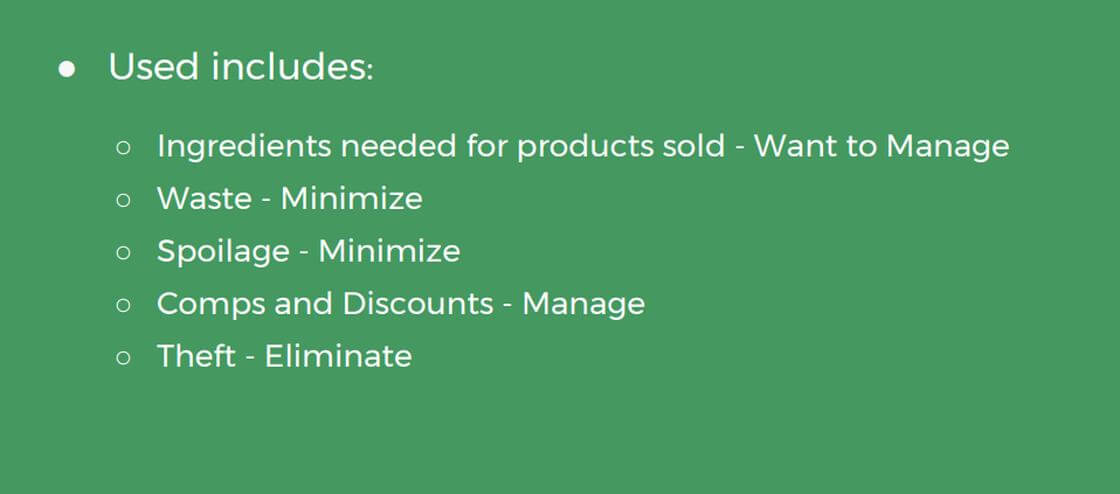
You have to watch out for waste, what’s thrown away; spoilage, what food got too old in the coolers and had to to be thrown out. Some discounts are discretionary decisions made, but when they’re done to freely or without too much thought, it can add up to a significant cost of goods charge.
The last one is the mortal enemy of a restaurant. If you think about a restaurant as a bank, and the only assets are in the bank is cash. Cash in the bank. Anything that leaves the bank that isn’t checked out or paid for is stolen and reduces profit. So that is one of the biggest enemies of any restaurant. It’s also one of the hardest things to manage. Not only do you need trust in the people that work for you, but you need systems; still trust but verify. Here is where measuring activities and seeing what’s happening at each stage in a restaurant with the numbers comes in very handy. It’s much easier to pick up theft when you look at specific percentages spike out of the ordinary for a period that doesn’t look like it matches what happened in the store. That can very easily be theft.
Labor – Controllable Costs Produces The Customer Experience
I’m going to get on my soapbox here for a second and repeat something that I learned early on from Danny Meyer. Mark Schulze at the Ritz Carlton and Pano Karatassos at Buckhead Life re-emphasized it.
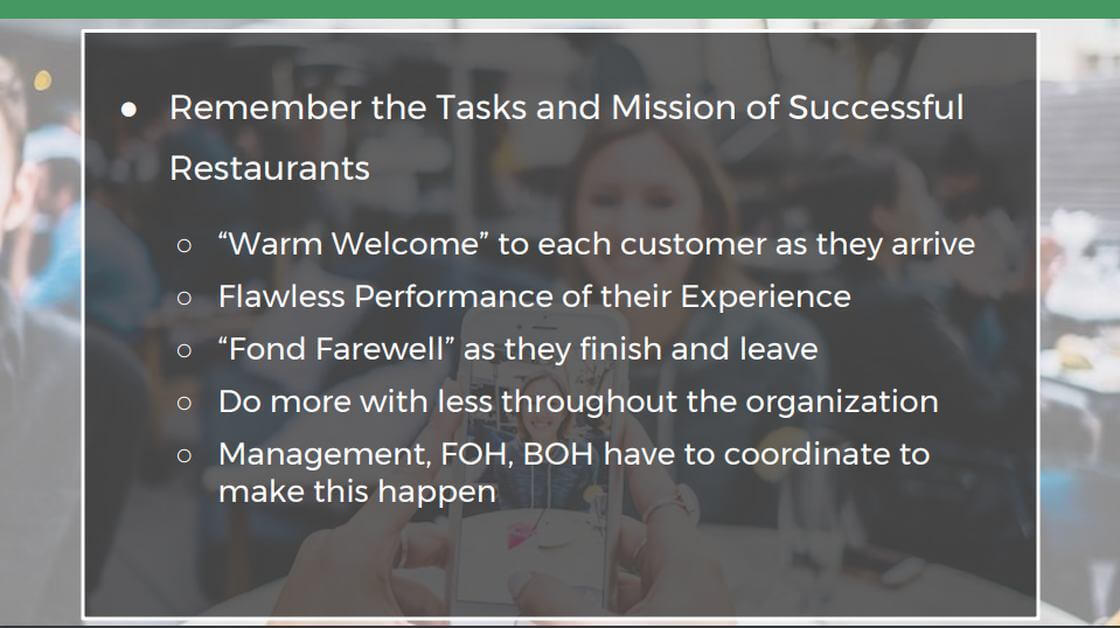
The mission of a successful restaurant is to provide a warm welcome to each customer as they arrive. Everybody does this slightly differently, but now there are more and more merging databases that show the history of your customers, that when you receive reservations, you can see the past experiences and remind the customer. Can we serve you what you ordered last time? Can we get you your gin and tonic? Things that say we know you we remember you, welcome back.
The second is a flawless performance of their experience. No missteps. Everything they expect happens in a timely well-done way, and so there are no big upsets that occur during the experience.
The last one I see that is the least in most restaurants, and that I have experienced is the fun farewell. It’s the thanks for coming, see you next time. It’s something that says we appreciate you being here and we look forward to you returning. It’s easy for a customer to sign a check, add a tip, get up and leave without connecting to anyone in the restaurant during that experience. One of the most significant areas of complaint I’ve heard in my restaurant advisory experience is that at the end of the meal, you can’t flag the server down to get the check, give him the credit card or to finish the out the bill. The end of the meal is when the server should be providing that crowning bit of caring and concern. I hate to say it because I was a 35-year season ticket holder for the Atlanta Falcons but that’s like the early Falcon years when they drove 98 yards to the 2-yard line and fumbled. It’s snatching defeat from the jaws of victory. Servers ought to know the end of the meal is the most crucial time to make customers feel appreciated and check in with them to let them know you enjoy having them and can’t wait to see them again. I find that to be the most neglected part of that experience with customers.
Our task is to do more with less throughout the organization. Good restaurant operators are always looking at how can we do more, provide more service, offer more value, at less cost. That is a constant mission. To do that, management, the front of the house, and back of the house have to consistently coordinate and talk to each other to make this happen. It doesn’t happen by accident.
Labor Costs Include
So that people understand, labor costs are not only front of the house or back of the house.
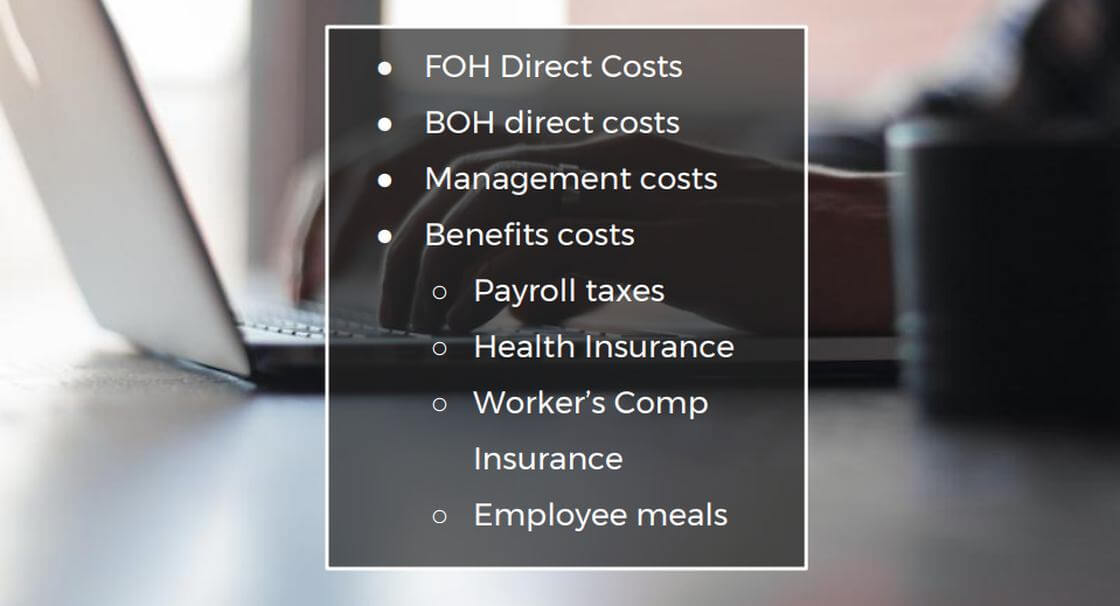
Labor cost also includes management; the folks that are there every day watching over the restaurant or the restaurants. It includes their costs, and everyone’s benefit costs, payroll taxes, health insurance, workman’s compensation and employee meals; all those are part of your labor costs.
This and food cost in the cost of goods sold are the two most substantial numbers on the profit and loss of virtually every restaurant. These are the ones that require the most attention and the most management, to keep them under control. We talked earlier about the idea of matching the front of the house and the back of the house to the ebb and flow of preparing the meals, providing the meals, and then doing the cleanup. From the front of the house staffing for early arrivals, the bulk of the traffic in peak serving times, and then winding down when serving times start declining. That’s a precise process and one that you will be amazed at how much impact it will have on your profit and loss if you are doing it effectually.
Other Costs In The Profit And Loss
While not as important as cost and labor, other costs still have to be watched.
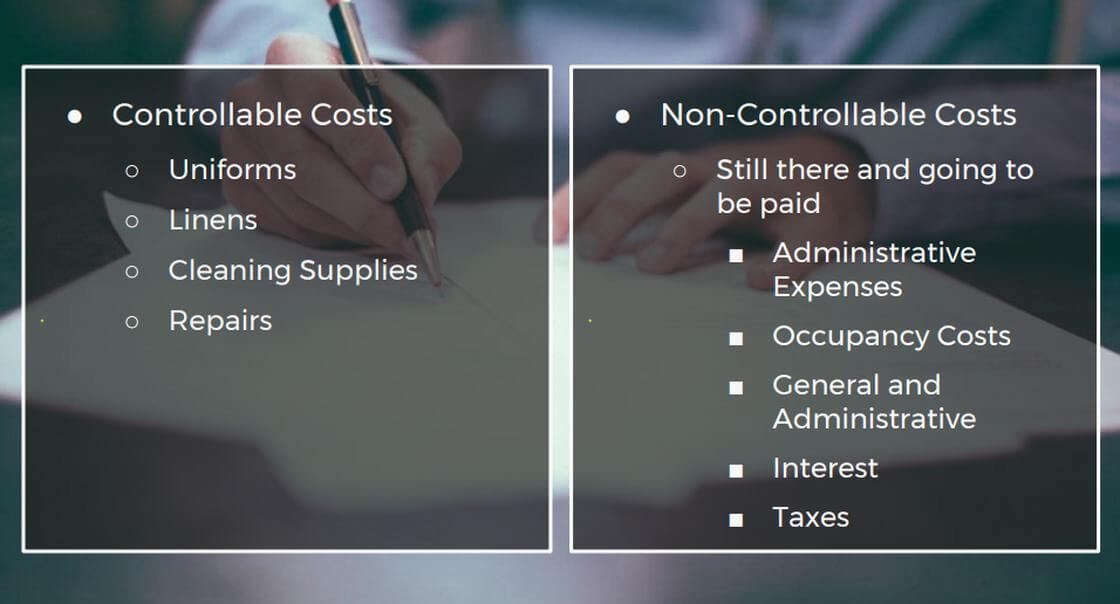
In the controllable column, we have uniforms, linens, cleaning supplies, paper supplies, marketing, and repairs. These are things that we can impact by watching closely how these items are used and keeping those costs to a minimum.
Non-controllable costs are there no matter whether the doors are open or not. These are administrative expenses, occupancy costs, the rent including the utilities, the maintenance, and repairs, general and administrative such as legal fees, accounting fees and other types of support services that are needed, interest, and taxes.
There is going to be a level of costs that one must not ignore by inefficient operation of the restaurant. There will have to be enough margin to overcome these cost for the business as a whole to be profitable.
Targets to Work For – Where Do They Come From?
What I see happen at many group staff meetings is that management will sit down and say, “We were over the target by this amount or this percentage.” The front of the house hears they are over budget, the back of the house hears their food costs are too high, and everyone feels like this is a punitive report card. It’s the kind of meeting where numbers become your enemy. That isn’t really what it’s happening. It’s very easy for numbers to wind up being these black and white things that seem to point fingers and cause people to get defensive. They are measurements against estimates that management is making on what it is going to take to realize a bottom-line profit.
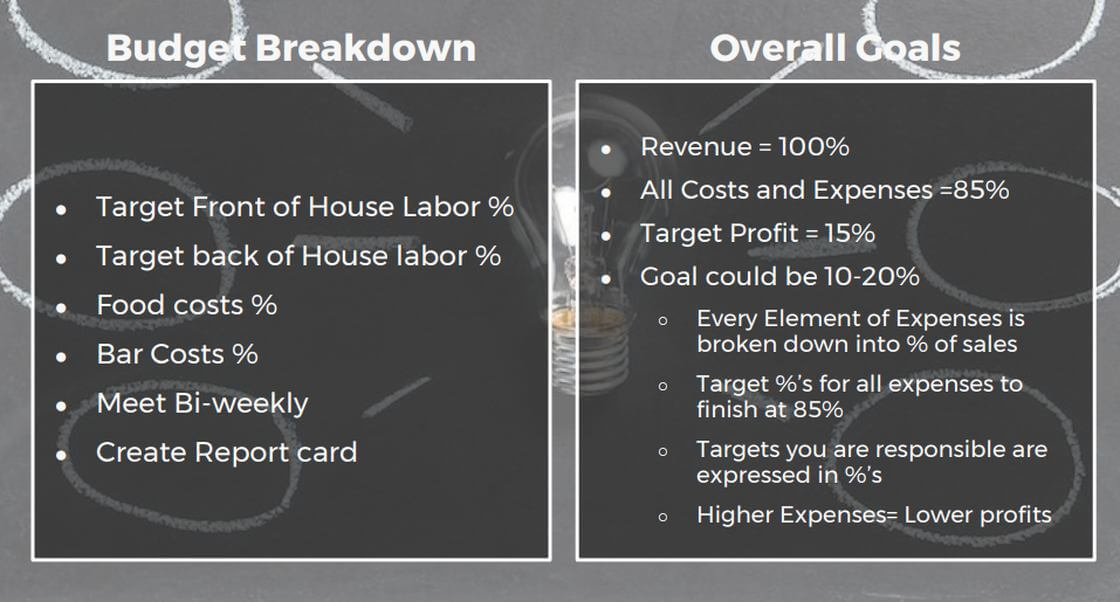
You start with 100% of revenue then each cost and category gets a percentage of that 100% allocated to it. There are industry standards you can go to depending on your type of restaurant. Types of restaurants are fast food, casual dining, quick service, and fine dining. Every category has got a set of standards or industry-wide percentages, and they go into finite detail. Make sure that you’re using that kind of standard costs. The owner is going to be aiming at a profit of 10% to 20% of revenue. If we assume a target profit of 15% then every variance from the percentages that are added up to that 100%, that are over what they should be, will take away from that 15%. You will be amazed at how quickly that disappears.
We put on a seminar last year for the GRA called the 2% Time Bomb and how to avoid it. The point of that was for managing to strict performance standards can shave off 2% here, 2% there, and suddenly you are profitable. If you ignore them or let those variances get out of control, as little as 2% variances in categories that matter can add up and take all your profit away. There is not a lot left in a well-run operation, so if you’re not managing to those very, very strict numbers, and trying to pick apart what caused it to go over, and fix it, then you won’t wind up at the end of the day with that targeted profit.
Looking at any report, you will be looking at revenue, food cost, labor cost, and all these other expenses as a percentage of sales. Variances in that will affect any number that’s higher than its supposed to be, and it is subtracted from that 15%; as you can see it will go away in a hurry.
Tight management of cost and effective activities can make a big difference in whether you make a profit or not. I will say that restaurants are characteristically the most fragile business sector in our economy. They have the lowest profit percent and the highest failure rate of any SSC code or industry code. That means the good ones, are good. It also says that if you are sloppy or careless, you will not be around. The margin is too narrow. You have to be on top of things. Everything should be broken down against that goal of 15% or 10% or 20%, based on your category.
An example that I like to refer to often is Danny Meyer. He built a career on developing state-of-the-art customer service standards and opened up many restaurants in New York City. Gotham Bar & Grill, Gramercy Tavern, Eleven Madison and others, all of which have been acclaimed as the best in the city in their category. He made very little money because the overhead was high and it was too difficult to manage to those standards, even with the high prices charged in New York City. He decided to try it from the other standpoint. Let’s try to do mass food to many people with lower margins and high volume. So he started Shake Shack. Shake Shack has made him personally very, very wealthy. He took all the experience he gained in the fine-dining world and applied it with quality service and quality products to a basic hamburger operation that is now public. He has probably created multiple millions of dollars of net worth, by understanding how to manage to numbers.
Each of us goes on that path in a separate way, but at the end of the day, we have to be looking at the numbers to understand what is happening.
Managing Anything Requires Three Steps
I’m going to share another principle I think each of you should have to operate by in your training tool-kit. Managing anything always works the same way. It doesn’t matter whether it’s restaurant, your budget at home, whether it’s anything that you want to have a fixed outcome, you have to plan what you want to happen.
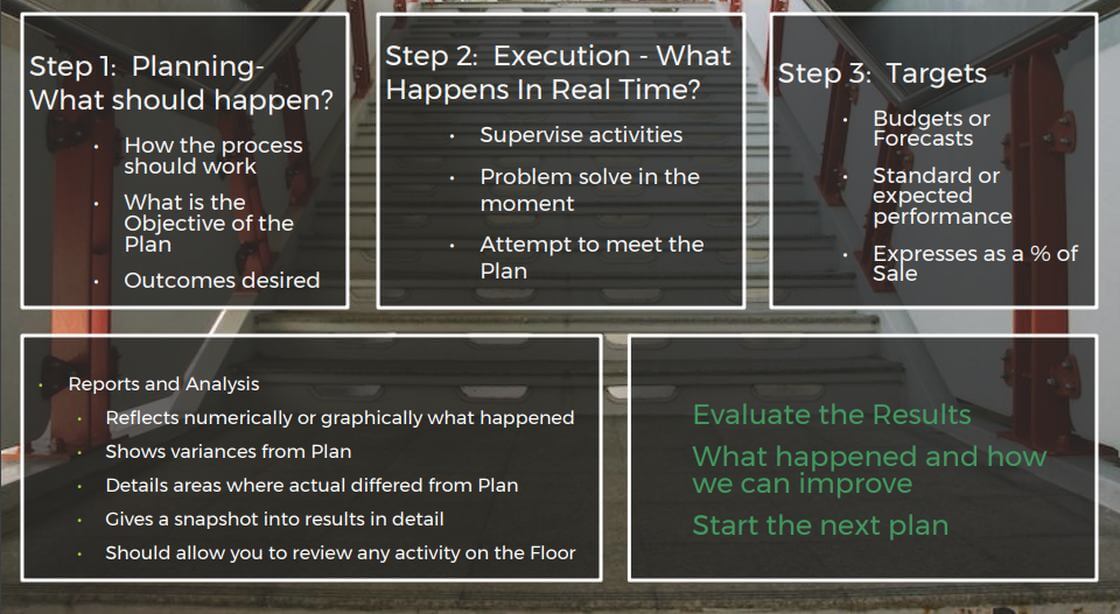
In a restaurant, you need to plan how the process should work for creating a perfect operation. What’s going to happen in the kitchen, what’s going to happen on the floor, what’s going to happen in the bar, and what’s going to happen when the customer walks in the door. So you have to plan how that’s going to work. Plan what the objective of that thing is regarding cost, customer experience, food quality, time limits, and delivery. What are the objectives for each of those processes? Then what are the outcomes desired, at the end of the day, the end of the week, and the end of the month? How should that have performed and how can you measure it?
There is another principle; you can’t manage what you can’t measure. So you have to figure out how you measure things. The second part of managing is the actual doing it, the execution. Living it in real time, supervising stuff on the fly, having radar eyes in the entire operation that you’re responsible for, understanding inefficiencies and taking care of it on the spot, problem-solving at the moment, while knowing that you’re after the plan. Your goal is to achieve your plan, not something imposed on you. All of that requires being very nimble at the moment to be sure that the execution happens to the best of your ability and the team’s ability.
The third step, the third leg of the stool is to step back from the execution and evaluate what happening. What were the outcomes, what were the results, what do those results say about how well you handled it at the moment? Then, start planning again.
So, it’s plan, execute, evaluate. That is management as simple as we can describe it. You look at Peter Drucker, and all his management treaties and all he talked and MBA School; everything comes down to plan, execute, evaluate.
In a restaurant, the planning part tends to take on a form of targets. These are budget or forecast laying out what performance standards should be or what they expected performance should be. Everything done is a percentage of sales. The execution part is what is going on in action and activity in the restaurants. The evaluate takes the form of reports and analysis and reflects analytically, numerically, or graphically what happened. It shows in a snapshot the results of what you saw in person, or if you have multiple locations, it becomes your snapshot remotely of what happened the previous day, night, or week. It shows variances from the plan. Those variances tell stories. They say we had too many people on the floor, too much waste; we gave away too many desserts to unhappy customers trying to keep them satisfied, it says something.
The key to managing is understanding what it’s telling you and dealing with that at the conclusion. If your reporting and analysis are complete, it should allow you to review any activity on the floor. This review is a real challenge because most reports you are probably looking at are what I would call extremely primitive high-level reports. However, it’s very practical for you to look at the activity, results, and performance of every staff person by every shift, by every hour, and by every customer, if you want that information. It’s also possible to look at the timeliness, the efficiency, and at the waste and spoilage that occurs in the kitchen. You can view by protein, by the plate, and by time. You can watch and understand the flow of what’s coming in and going out of the kitchen and what’s happening on the floor. Also, you can see which servers are actively taking care of the most customers in the best possible way with the highest per ticket and up-selling them into cocktails, wines, and desserts. All of this can be available through analytical reports if you know where to look and ask for it.
Sources of Reports
So, where do you get these reports? Restaurants tend to have three different places that provide the majority of these reports.
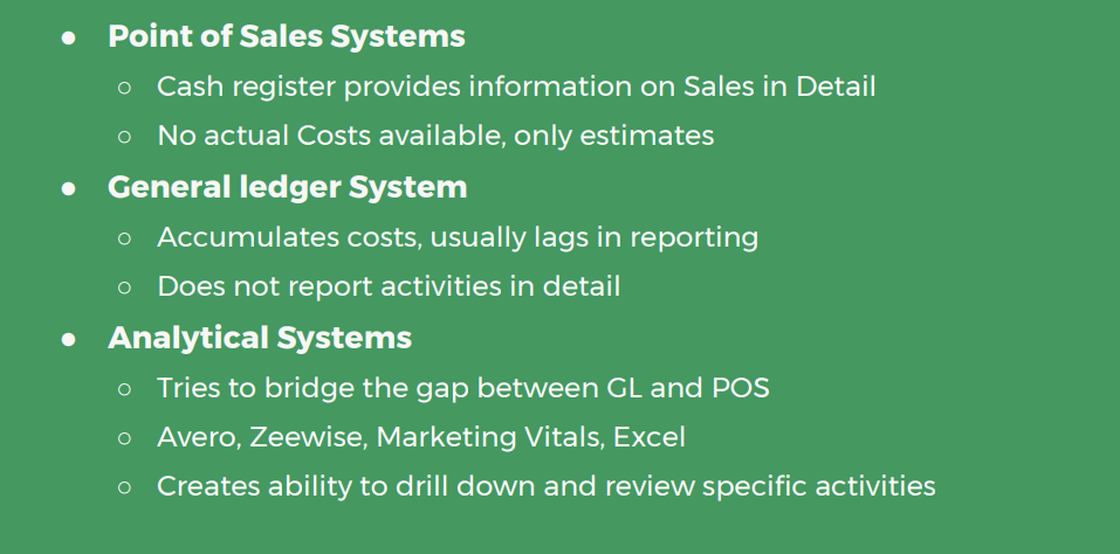
The first place to go is your point of sale systems. Almost everybody understands you have to have a credit card terminal/cash register. If you need to have a merchant service processor, it will turn those credit cards into cash. Many of you also understand that the provider of those services can give you reports of the activity through the point of sale register on certain kinds of activities in the restaurant. This is a neglected item in many operations, but know that much information is available such as daily service reports, sales by time, sales by a server, sales by category, and sales by menu items. Many things are available at that point of sale reporting portfolio. It makes sense for you to bring a representative from your point of sale company out and ask them what can you get out of that system that you are not currently using. They’re always developing new reports; they’re consistently working to create new value to compete with other merchant processors. You’ll be surprised to learn the kinds of things that they are willing and can do for you that you just haven’t asked for before. However, also understand the point of sale has one glaring hole in it; it cannot report costs. They’ll tell you it can, but what they’re saying is that you can estimate or put in standard costs, and it will add up all the sales against those costs and tell you what it thinks; were there profitable items or not?
However, your real costs are for the ones you’re writing checks. That information is in your general ledger. Your general ledger system tends to be your bookkeeping, financial statement preparation, and sales tax preparation; all of that compliance through a platform. We’ll talk about some of those in a second. It usually doesn’t give you on time, real-time information. Typically the lag of time is 30 to 45 days, and it doesn’t report activities on the floor in detail.
So many operators are sent to analytical systems to bridge the gap between the strengths and weaknesses of the general ledger and the point of sale. Avero, Zeewise and Marketing Vitals, and the ambiguities of Excel spreadsheets are analytical systems to help make sense of activity on the floor. This system allows us to look down, drill down, and review specific activities if we know how to use these different services.
New Platforms and Services
Virtual and Digital Reporting Platforms
Also, there are virtual and digital reporting platforms out there. I’ll take a quick second to say; we are moving out of the period of having on-premise computers, accounting systems, applications, IT staff, and people managing the input of daily checks and daily sales, into a world where all of that becomes virtual and automated. If you’re not in that world, you need to start learning about it because your competitors are learning about it and many of them have already gone this way.
What it means is a paperless office, a flow of activity through restaurants all hitting a digital environment as quickly as is practical. Then, the manipulation of those numbers in real-time to see what’s happening on the floor in the books, the cost, and the revenue, with a much more real-time environment.
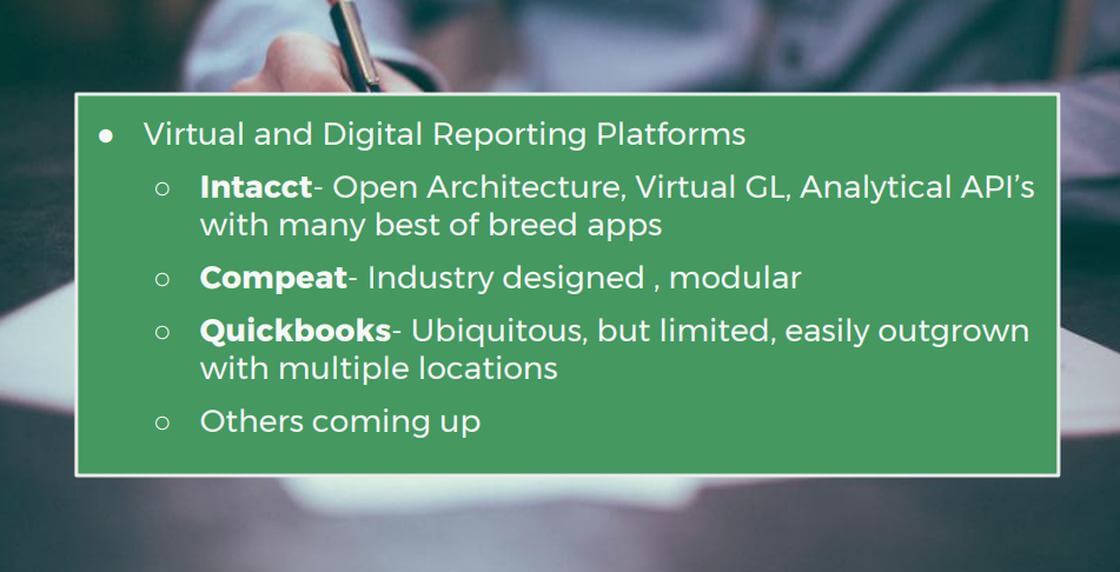
Intacct is probably one of the leading platforms endorsed by the ACPA, the parent organization to the accounting profession. It’s also the only accounting QuickBooks recommends when you outgrow the QuickBooks platform. Also, it’s one that certainly in the restaurant industry has become a spreading standard.
Compeat is another industry standard or industry designed program. It’s modular and you can pick and choose different elements that you think can help your business. It’s widely distributed and used.
The most used platform is still QuickBooks, it’s universal, but it’s limited. You can’t operate multi-location operations without an enormous amount of support from Excel spreadsheets. It does have API connections with many add-on services. QuickBooks design is for small businesses that have a limited number of transactions and usually a single location with a low payroll. People who are trying to use it for larger organizations, numerous transactions, with a higher number of employees are doing themselves a disservice. You’ve outgrown QuickBooks.
Others are coming up. Be aware the whole environment is moving out of computers, expensive computers that have to be replaced every three years with programs that have to be updated every year, with IT people keeping them going and with bookkeepers, clerks, and accountants inputting information. Don’t be left behind.
New Platforms and Services
Regarding Services, There Are Three That You Should Consider.
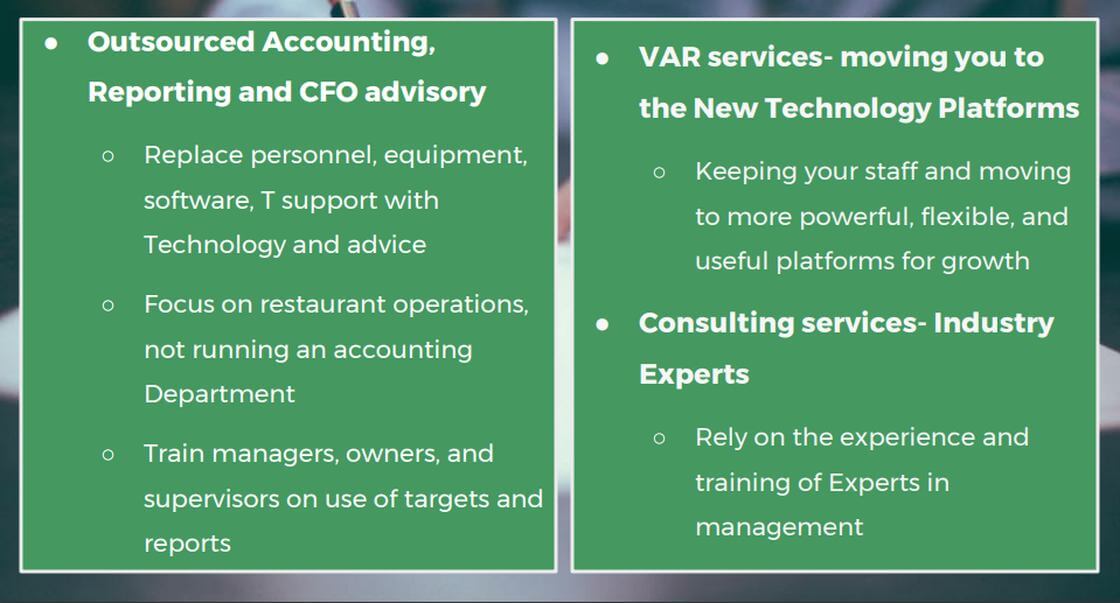
Outsourced Accounting Reporting and CFO Advisory
One is outsourcing the financial reporting entirely. Get out of the business of running an accounting business as well as an accounting business and let the pros take over. There are many providers to take that burden away; they remove the turnover of staff and vulnerability away and give you what you need in a much more accurate and timely way.
VAR Services
If you have a great staff that’s been there forever and is operating like a well-oiled machine but is on the old antiquated platform, there are several VAR operators to take you to this new virtual platform. They will install it, implement it, train your people and support you so that you have access to this new technology, and the improved and more straightforward way of running your business.
Consulting Services
There are always Consultants out there whom I call industry experts who can give you insights and Intelligence on how your operating and what you can do to improve.
Conclusion
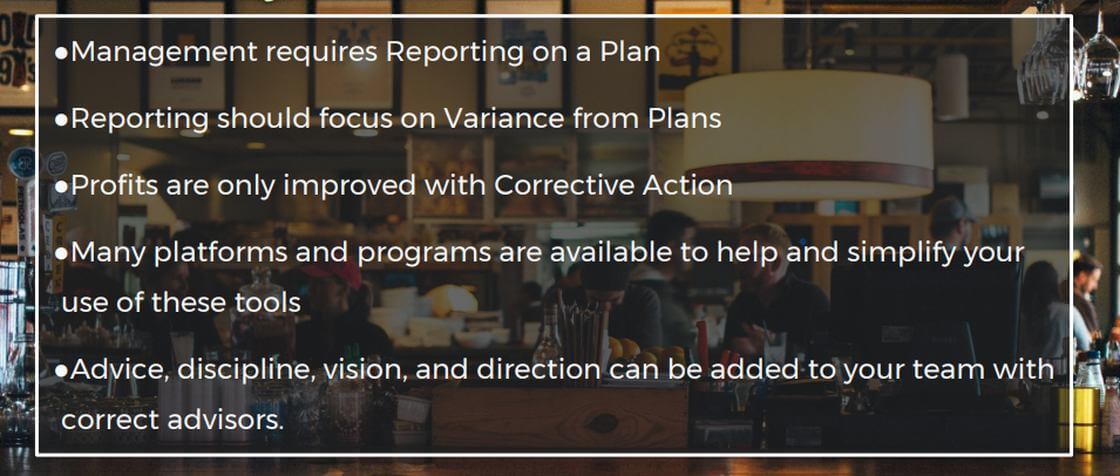
To manage, you’ve got to use reporting and compare it to a plan. Reporting should always focus on the variance and then solve the riddle of what caused the variation. Profits improve only with corrective action. You can’t sit there, mull over things and worry, and talk to your friends and the staff and get upset; that doesn’t fix anything. Action improves profits. Find the problem, solve the problem, fix the problem. There are many platforms and programs out there to help you simplify your business by using the tools while adding advice, discipline, and direction. If you don’t have it in your management team today, you can add it by picking the right advisors.
That’s our story for today. I want to thank you for attending, and I’m certainly available to talk further or answer questions in the future at Trusted CFO. We’re are located in Atlanta, and you can find us at www.tcfosolutions.com, or you can find me when you Google Steven Gross, CPA. I have no privacy, but I’m accessible all the time.
Feel free to contact us and use our resources at your leisure.
Questions
Will a recording and slide be available later?
Yes, they will, and you will also get an email tomorrow with the presentation and recording.
Where does one find Industry standards of COG for the various markets, for example, soft casual, QSR, fine dining, etc.?
There are a variety of studies in the marketplace. Some companies put these out quarterly. I know that Deloitte has an annual publication of hospitality performance numbers and there are many others. I would go to Google and look for “restaurant industry standard report,” and you’ll probably find ten providers with that kind of information.
How do you measure the performance of the servers regarding upselling the average check amount?
In the analytical tools available, whether it’s point of sale, some are sophisticated to do this, but indeed, Avero is a supplemental service. Marketing Vitals is another one that will allow you to drill down into the individual transactions of each credit card charge. Then, you can put together a report that will divide it up into servers. You can divide it up into menu items, check averages, and it gives you the reporting that shows you, as a pattern, who is selling the most wine, who is selling the most expensive wine, who is selling the most cocktails, and who is selling the most deserts. All of that information is available in these analytical reports that support the restaurant industry and are using the point-of-sale information as the data feed.
How do I have point-of-sale in general ledger talk to each other?
That’s a great one because that’s where things fall the most. You tend to have the restaurant managers looking at the point of sale and the accountants looking at the general ledger. The gaps between them are significant, especially the point-of-sale. There are many analytical programs out there, or the platforms themselves will do this. They accept the data feed from the point of sale, and they also are virtually doing the accounting. They can reconcile one to the other automatically. You need to be able to put into those performance numbers actual costs as they are being reported, or paid for through the back door by check or credit card. That needs to be live information as soon as it happens. So those two need to be brought together either by a third-party program or by the virtual platform you’d be using.
How can I have my Financial statements available sooner?
Typically, in the old environment, let’s say QuickBooks as an example, you’re putting in every check, daily sales, and the payroll. The end of the month comes along, and you start reconciling, then closing out your books by the 10th or 15th. You have in a well-run company, on the old platforms you’ll have financial information from the financial statement. In this virtual platform world, you can do it every day if you want. Because it’s living in a digital world, it automatically reconciles, and it is automatically up today. That is one of the benefits of moving out of the traditional on-premise, block, and tackle, linear accounting system, into these new virtual platforms. It’s very similar to going on Amazon, and as soon as you buy something you track it from the time it leaves the warehouse on the truck, arrives in your city, into your building and is delivered. The same principle applies here to the restaurant world.
How do you encourage owners or general managers to take an interest in the numbers? I provide bookkeeping services to restaurants and bars, and I seem to be more concerned about the numbers than my clients.
You can start with whether or not they are making any money. You could say, “Wouldn’t you like to make more?”
Those who pay little attention to performance tend to perform poorly. I would take the role of being a teacher and a coach. Not imposing it but offering it and seeing what you can do, like putting on training sessions or classes for the managers on how to measure and manager activity. Help them see how they can look at what’s going on numerically to understand whether or not things are going well. People will not do things they’re not comfortable doing, so you have to help them get comfortable. That’s the first step.
Do you recommend Compeat or Intacct and why?
I think there are different programs for different reasons. It is particularly valuable for multi-location, complex operations. It is a very robust and thorough platform. It’s open architecture, so it allows the API connection to ADP, Paychex, HR programs, Hot Schedule, job costing, and construction accounting. Compeat tends to be more focused on the back and front of the house measurements. It’s a good fit for smaller single location operations that have minimal real estate, aren’t building things, and don’t have the complexity of multi-format restaurants. For them, it’s a good solution.
How about a webinar on internal restaurant controls?
That would be fun to do. There are some more exciting technologies at the end of the day. Let’s say to provide supervision, detection, deterrence, and documentation of misbehavior is getting expensive enough that people can have that technology embedded in the restaurants to watch out for and supervise that area as well. It’s called internal control. Ask the GRA to provide that and will be happy to support them in doing it for you.
Where do I go to learn about new apps and services available to help me run my business?
I would go to your current advisors and your point of sale providers. This is indeed what we do and is in our wheelhouse. However, there are a lot of services, applications, and tools available to help you run your restaurant effectively than any of us have had in the past. It’s very much like 3 to 4 years ago there was no Uber, now we’re all using Uber. It’s the same in this space, and many things are coming that are quite fascinating regarding increasing revenue as well as control costs. Be inquisitive, ask questions, talk to people who are useful in technology. If you’re a franchisee speak to the franchisor; go to where the talent is and ask many questions, do a lot of investigations. Google is fantastic for “how do I do XYZ,” and you’ll come up with a whole lot of things to look at and explore. Be curious.
Does Trusted CFO Solutions help multi-unit independents as well as franchisees?
Yes, we do. Our sweet spot in representation is in growing dynamic businesses that are outstripping their C-Suite talent. They need planning, sophisticated measurement, and management systems, and need to understand how to use them to build their business and increase profits. We also add virtual CFO services to them. So, we help our clients by putting together financing packages, finding investors, and work with expanding businesses in ways other than financial reporting.
How many units do I need to own to get the best value in working with your company?
The easy answer is how many do you want to be? We’ve worked with customers who have as few as two or three, but who plan to be at ten in two years and twenty in three to four years. Moreover, they wanted to build their infrastructure on something that would accept that kind of growth. If a company only has a few and is comfortable and making enough money out of that to be satisfied, that’s probably not a fit. However, if you’re ambitious, you want to grow, have big plans and want to have it happen simply and as efficiently as possible, we’re a good fit.
Thank you to all our attendees this afternoon. Thank you to Steve for presenting on this important topic.

Tags
Outgrowing Quickbooks?
Say goodbye to spreadsheet reporting and manual consolidations and start using a cloud-based financial management system.
Related Content
Wrap-Up: Reimagine Your Month-End Close with Sage Intacct
Best Practices to Perfect Your Month-End Close With Sage Intacct
Decoding the Challenges of the Month-End Close
Fast-Track Your Financials: Techniques to Slash Your Month-End Close
Take Control of the Month-End Close: A Checklist for Success
Managing Your Accounts Payable: A Guide for Small Business Owners
© Trusted CFO Solutions.
